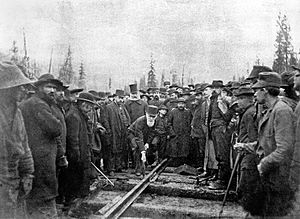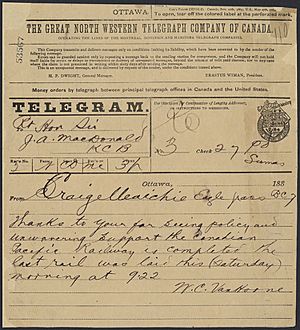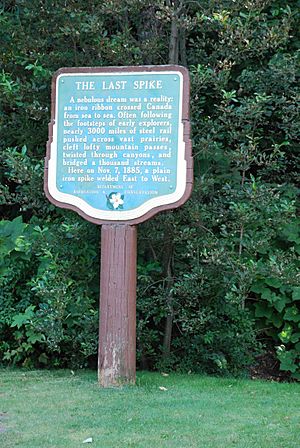Last spike (Canadian Pacific Railway) facts for kids
A special spike was hammered into the Canadian Pacific Railway (CPR) at Craigellachie, British Columbia, on November 7, 1885. This happened at 9:22 am. A man named Donald Smith, who helped fund the railway, drove in this final spike. It marked the end of a huge project to build Canada's first railway across the country. The project faced many challenges, like natural disasters, money problems, and even a rebellion.

Contents
Building the Canadian Pacific Railway
The moment the last spike was driven in showed that the CPR was finished. This railway became a big symbol of Canada being united as one country. Even though the last spike was in, trains couldn't run all the way through until June 1886. This was because special tunnels and covers called snowsheds still needed to be built in places like Rogers Pass and Kicking Horse Pass to protect the tracks from snow.
Why the Railway Was Built
The railway's completion kept a promise made in 1871 by the Canadian government. They had promised British Columbia that a railway would connect it to Central Canada. This promise was a main reason why British Columbia decided to join Canadian Confederation, which is when different parts of Canada joined together to form the country we know today.
However, different governments struggled with the project. By 1881, which was the original deadline, not much of the railway was built. This made some politicians in British Columbia threaten to leave Canada. So, a new company, the CPR, was given the job. They were given ten more years to finish the railway, but they did it in just five!
The Role of Chinese Workers
Many Chinese laborers worked very hard on this railway. Their contribution is often forgotten. It's important to remember that no Chinese person is seen in the famous "Last Spike" photograph. These workers faced tough conditions and were paid less than others. They played a huge part in building the railway.
The "Last Spike" Story
The "last spike" ceremony for the CPR was a bit unusual. Unlike other railways that used fancy gold or silver spikes, the CPR's "last spike" was just a normal iron spike. It was like all the other spikes used to build the tracks.
The Silver Spike
A special silver spike was made for the Governor General, Henry Petty-Fitzmaurice, 5th Marquess of Lansdowne. He was supposed to be at the ceremony. But bad weather made him go back to Ottawa, Ontario, with the silver spike. This silver spike stayed with the Van Horne family until 2012. They then gave it and other items to the Canadian Museum of History in Gatineau, Quebec.
Donald Smith's Bent Spike
The iron spike that Donald Smith hammered was bent badly when he hit it. A worker named Frank Brothers pulled out the bent spike. It was then given to Smith as the "last spike." Smith had the bent spike straightened. He cut small pieces of iron from it. These pieces were decorated with diamonds and given to the wives of some people at the ceremony. This spike was later given to the Canada Science and Technology Museum in Ottawa. It is now on display at the Canadian Museum of Immigration at Pier 21 in Halifax, Nova Scotia. It honors the many immigrant railway workers who were so important to building the railway.
Smith later used another iron spike, sometimes called "the ordinary" or "fourth spike." He used it to make more jewelry for the wives of other officials. These pieces were made with larger strips of iron to show they were different from the first ones.
The Second Last Spike
The spike that Smith successfully hammered in right before the "last spike" was quickly taken out of the track. This was done to stop people from taking it as a souvenir. A regular spike was put in its place. This "second last spike" was given to the son of the head of the patent office at that time. It is still owned by that family today. It has been shaped into a carving knife.
The famous photo of Donald Alexander Smith driving in the last spike was taken by a photographer from Winnipeg named Alexander J. Ross.
The Last Spike in Culture
The story of the CPR's building and completion is told in many ways.
- Books: Pierre Berton wrote two popular books, The National Dream and The Last Spike.
- TV Show: These books were made into a Canadian TV show called The National Dream. It was an eight-part series that first aired in 1974. Millions of people watched it, setting a record for CBC.
- Poem: A long poem called Towards the Last Spike was written by E. J. Pratt.
- Board Game: A board game called The Last Spike was made. Players had to finance and build a railway across Canada.
- Canadian Passport: The current Canadian passport shows the last spike on pages 10 and 11. It also includes the famous photo of Donald Alexander Smith.



